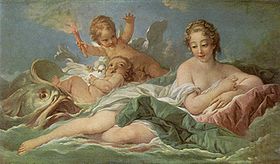พุตโต


เปมเทพ หรือ พุตโต หรือ พุตตี (อังกฤษ: Putto หรือ putti (พหูพจน์)) เป็นประติมากรรมรูปเด็กอ้วนยุ้ยและส่วนใหญ่แล้วจะเป็นเด็กผู้ชาย, เปลือย ใช้ในการตกแต่งและพบบ่อยในสมัยฟื้นฟูศิลปวิทยาอิตาลี และศิลปะบาโรกในเยอรมนี พุตโตมาจากศิลปะโบราณแต่มาพบใหม่เมื่อต้นสมัยศิลปะควอตโตรเช็นโต (Quattrocento) และมักจะเรียกสับสนกับเครูบ (Cherub หรือ cherubim)[1]
ที่มา[แก้]
คำว่า “putto” เป็นภาษาอิตาลีที่เป็นเอกพจน์ เพศชาย พหูพจน์ใช้ “putti” ถ้าเป็นเพศหญิงใช้ “putta” แต่มิได้ใช้กันเพราะเป็นคำย่อของคำว่า “puttana” (หญิงสำส่อน) ในภาษาอิตาเลียนสมัยใหม่ “พุตโต” หมายถึง “เด็ก” และใช้ในบางกรณีเท่านั้น
ในการบรรยายทางศิลปะ “พุตโต” กล่าวถึงเป็นครั้งแรกโดยจอร์โจ วาซารี (ใน “ชีวิตศิลปิน” ค.ศ. 1550/ค.ศ. 1568)
ประวัติ[แก้]
พุตโต คิวปิด และทูตสวรรค์ พบทั้งในงานศิลปะทางโลกและทางศาสนาตั้งแต่ราวคริสต์ทศวรรษ 1420 ในอิตาลี และเมื่อต้นคริสต์ศตวรรษที่ 16 ในเนเธอร์แลนด์ และเยอรมนี
การฟื้นฟูการใช้ในศิลปะสมัยฟื้นฟูศิลปวิทยา[แก้]
การใช้ยุวเทพในศิลปะคลาสสิกใช้ประดับโลงหินของเด็กในคริสต์ศตวรรษที่ 2 ที่เป็นรูปทะเลาะกัน, เต้นรำ, เข้าร่วมพิธีกรรม, เล่นกีฬาและอื่นๆ การนำยุวเทพกลับมาใช้เชื่อกันว่าเริ่มโดยโดนาเทลโลในฟลอเรนซ์ในคริสต์ทศวรรษ 1420 แม้ว่าจะมีงานอื่นก่อนหน้านั้นเช่นที่เห็นในที่ฝังศพในลุกกา
การใช้ในศิลปะบาโรก[แก้]
พุตโตนิยมใช้กันมากในงานตกแต่งในเยอรมนี เช่น การตกแต่งแท่นบูชา หรือแท่นเทศน์ หรือในจิตรกรรมหรือจิตรกรรมฝาผนัง ซึ่งอาจจะใช้พุตโตในการถือเครื่องไม้เครื่องมือหรือเครื่องตกแต่ง
ระเบียงภาพ[แก้]
-
“วีนัสส่องกระจก”
เดียโก เบลัซเกซ -
“จูปแรก”
วิลเลียม-อดอล์ฟ โบเจโร -
ถือเทียนประกอบแท่นบูชาเอกที่อารามออทโทบอยเริน
-
จิตรกรรมผสมประติมากรรมเหนือฉากประดับแท่นบูชานักบุญมาร์ตินที่อารามออทโทบอยเริน
-
แบกลูกโลกประดับกางเขนและล้อมรอบพระเจ้าเหนือฉากประดับแท่นบูชาเอกที่อารามฮอลเซินในเยอรมนี
-
ปีนป่ายบนเสากระโดงแท่นเทศน์ที่อารามเอียร์เซในเยอรมนี
-
ยืนข้างตราอาร์มที่อารามไรเต็นฮาสลาคในเยอรมนี
อ้างอิง[แก้]
- ↑ Art historian Juan Carlos Martinez writes: "Originally, Cherubs and Putti had distinctly different roles, with the former being sacred, and the latter, profane. That is, Cherubs and Seraphs (Cherubim, Seraphim) are Angels, occupying the highest angelic orders in Heaven and are thus the closest to God. On the other hand, Putti, arise from Greco-Roman classical mythos (i.e., non-Christian). They are associated with Eros/Cupid as well as with the Muse, Erato; the muse of lyric and love poetry... "Putti – which comes from the Latin, putus, meaning 'little man' – are...not so much babies as they are 'not human'. They are spiritual beings and thus depicted in their typically odd fashion; as winged little people of indeterminate gender. Using babies as models for Putti (or for Cherubs, either) doesn't quite get across the true concept of 'Putti-ness' as they (babies) are too guileless, for one thing, whereas Putti are clever and purposeful. They are there to help Cupid/Eros facilitate the onset of profane love – or secular, non-religious love, as between two people, rather than the love as between a human and God. Probably, it was artists' attempts to avoid simply painting babies that has led to so many rather odd and, often, ugly, Putti. Sometimes they nailed it, sometimes not. "By the time the Baroque Era came about, which might arguably have been the high point for Cherubim and Putti, both of these little beings were usually being depicted in the same way. Which one they were, simply depended upon the theme of the painting or sculpture: If religious (sacred) – they were Cherubs. If secular or mythic (profane) – they were Putti. "In either case, they'd be hard to pull off successfully today because most people are unaware of their roles in semiotics, or in philosophy/mythology/history, or in religion." (Martinez, Juan Carlos. "What's With the Cherubs?" ARChives - Essays and Information on Art by Today's Experts and Professionals. Art Renewal Center, 10/5/2004[1] เก็บถาวร 2007-09-28 ที่ เวย์แบ็กแมชชีน)
ดูเพิ่ม[แก้]
แหล่งข้อมูลอื่น[แก้]
![]() วิกิมีเดียคอมมอนส์มีสื่อเกี่ยวกับ พุตโต
วิกิมีเดียคอมมอนส์มีสื่อเกี่ยวกับ พุตโต










